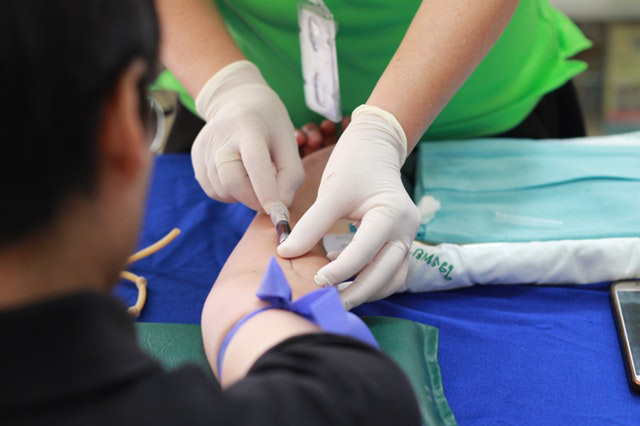The Basic Principles Of Northeast Medical Institute - New Haven Campus Phlebotomy Course & Cna Class
The Basic Principles Of Northeast Medical Institute - New Haven Campus Phlebotomy Course & Cna Class
Blog Article
Northeast Medical Institute - New Haven Campus Phlebotomy Course & Cna Class for Beginners
Table of ContentsSee This Report on Northeast Medical Institute - New Haven Campus Phlebotomy Course & Cna ClassHow Northeast Medical Institute - New Haven Campus Phlebotomy Course & Cna Class can Save You Time, Stress, and Money.Northeast Medical Institute - New Haven Campus Phlebotomy Course & Cna Class Can Be Fun For EveryoneNortheast Medical Institute - New Haven Campus Phlebotomy Course & Cna Class Things To Know Before You Get ThisSome Known Details About Northeast Medical Institute - New Haven Campus Phlebotomy Course & Cna Class The Single Strategy To Use For Northeast Medical Institute - New Haven Campus Phlebotomy Course & Cna Class
The usage of such tools need to be gone along with by various other infection prevention and control practices, and training in their use. Not all safety and security gadgets are appropriate to phlebotomy. Prior to choosing a safety-engineered device, customers should extensively examine offered tools to identify their ideal usage, compatibility with existing phlebotomy practices, and efficiency in shielding personnel and patients (12, 33).For settings with low sources, price is a motoring variable in purchase of safety-engineered tools. Where safety-engineered tools are not offered, knowledgeable use of a needle and syringe is appropriate.
Among the crucial pens of high quality of care in phlebotomy is the participation and cooperation of the client; this is mutually helpful to both the health and wellness employee and the client. Clear info either written or spoken need to be offered to each patient that goes through phlebotomy. Annex F supplies example message for discussing the blood-sampling procedure to a person. labelling); transportation problems; interpretation of outcomes for professional management. In an outpatient department or clinic, give a devoted phlebotomy workstation containing: a tidy surface with two chairs (one for the phlebotomist and the other for the patient); a hand laundry basin with soap, running water and paper towels; alcohol hand rub. In the blood-sampling space for an outpatient department or center, supply a comfy reclining couch with an arm remainder.
The Basic Principles Of Northeast Medical Institute - New Haven Campus Phlebotomy Course & Cna Class
Make sure that the indications for blood tasting are clearly specified, either in a written protocol or in documented guidelines (e.g. in a lab type). Accumulate all the tools required for the procedure and place it within secure and easy reach on a tray or trolley, making sure that all the products are plainly visible.
Present yourself to the client, and ask the patient to mention their complete name. Check that the research laboratory form matches the person's identity (i.e. match the patient's details with the research laboratory type, to make certain accurate recognition).
Make the person comfy in a supine setting (if feasible). Location a clean paper or towel under the person's arm. Talk about the test to be carried out (see Annex F) and obtain spoken authorization. The client has a right to refuse an examination at any moment before the blood tasting, so it is very important to make sure that the client has comprehended the procedure.
Some Known Questions About Northeast Medical Institute - New Haven Campus Phlebotomy Course & Cna Class.
Prolong the patient's arm and evaluate the antecubital fossa or lower arm. Situate a capillary of a great size that is visible, straight and clear.
DO NOT put the needle where capillaries are diverting, due to the fact that this increases the opportunity of a haematoma. Locating the capillary will help in figuring out the appropriate size of needle.
Specimens from central lines carry a danger of contamination or incorrect lab examination results. It is appropriate, but not optimal, to attract blood samplings when initial introducing an in-dwelling venous device, before connecting the cannula to the intravenous fluids.
Northeast Medical Institute - New Haven Campus Phlebotomy Course & Cna Class Fundamentals Explained
Failing to enable adequate call time raises the danger of contamination. DO NOT touch the cleansed site; in specific, DO NOT put a finger over the capillary to direct the shaft of the revealed needle.
Ask the client to form a hand so the veins are a lot more noticeable. Go into the vein promptly at a 30 level angle or much less, and remain to present the needle along the capillary at the easiest angle of access - CNA Classes. As soon as enough blood has actually been accumulated, release the tourniquet BEFORE withdrawing the needle
Unknown Facts About Northeast Medical Institute - New Haven Campus Phlebotomy Course & Cna Class
Withdraw the needle carefully and use gentle pressure to the website with a clean gauze or completely dry cotton-wool round. Ask the client to hold the gauze or cotton wool in place, with the arm expanded and elevated. Ask the patient NOT to flex the arm, because doing so causes a haematoma.

5 Easy Facts About Northeast Medical Institute - New Haven Campus Phlebotomy Course & Cna Class Explained
Where possible, maintain the tubes in a shelf and move the rack towards you - https://telegra.ph/Northeast-Medical-Institute-New-Haven-Campus-Phlebotomy-Course--CNA-Class-06-29. If the example tube does not have a rubber stopper, inject exceptionally slowly into the tube as decreasing the stress and velocity utilized to transfer the sampling lowers the risk of haemolysis.

Report this page